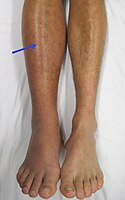
Photo from wikipedia
Diseases such as myocardial infarction, ischaemic stroke, peripheral vascular disease and venous thromboembolism are major contributors to morbidity and mortality. Procoagulant, anticoagulant and fibrinolytic pathways are finely regulated in healthy… Click to show full abstract
Diseases such as myocardial infarction, ischaemic stroke, peripheral vascular disease and venous thromboembolism are major contributors to morbidity and mortality. Procoagulant, anticoagulant and fibrinolytic pathways are finely regulated in healthy individuals and dysregulated procoagulant, anticoagulant and fibrinolytic pathways lead to arterial and venous thrombosis. In this review article, we discuss the (patho)physiological role and laboratory assessment of fibrin, factor XIII and endogenous fibrinolysis, which are key players in the terminal phase of the coagulation cascade and fibrinolysis. Finally, we present the most up-to-date evidence for their involvement in various disease states and assessment of cardiovascular risk.
Journal Title: International Journal of Molecular Sciences
Year Published: 2021
Link to full text (if available)
Share on Social Media: Sign Up to like & get
recommendations!